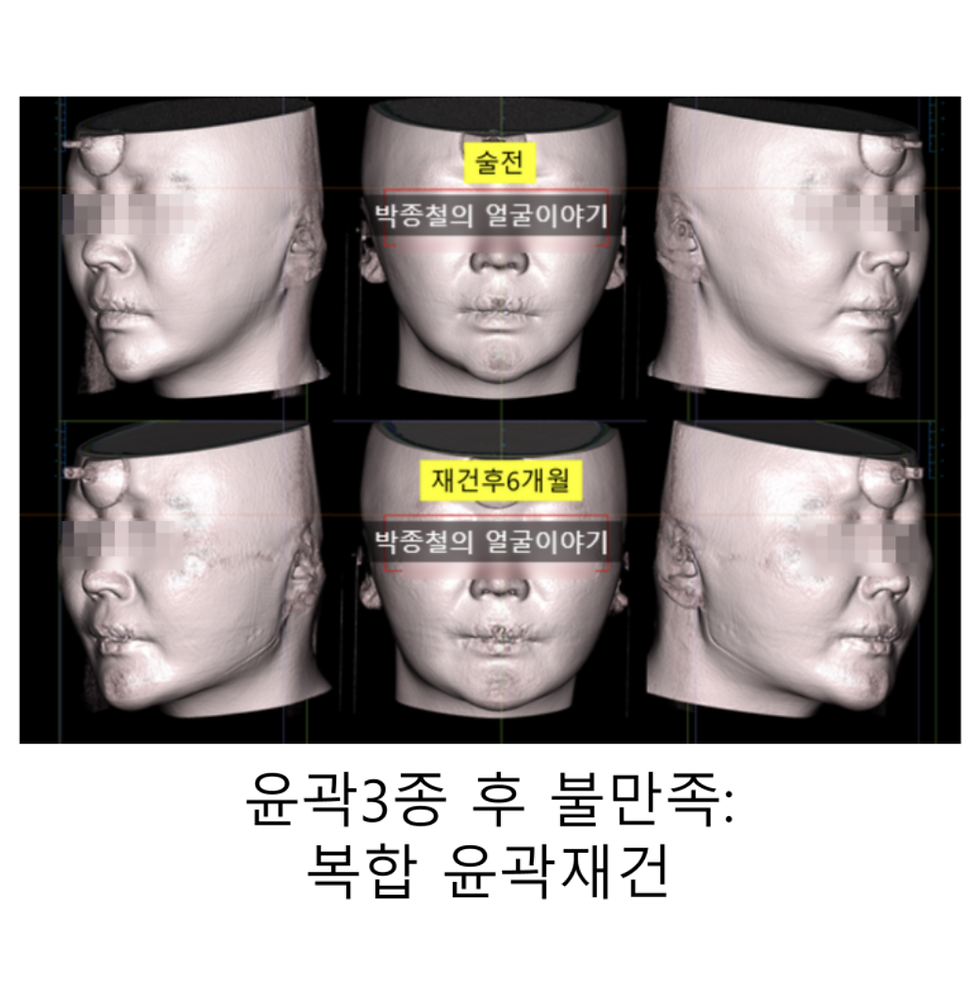Chin Augmentation for Recessed Chin and Facial Asymmetry Correction: 3D CT Analysis of Male 3-Point Facial Contouring Surgery
- Dr. Park

- Jun 7
- 3 min read
By Dr. Park Jong-chul, Oral and Maxillofacial Surgeon
This posting presents an in-depth case study of a male patient who underwent 3-point facial contouring surgery. We will provide an objective analysis, supported by 3D CT data, of the surgical planning and the transformative results at the 3-month post-operative mark, focusing on the correction of a recessed chin and facial asymmetry.
Patient's Chief Complaint and Pre-operative Analysis

The patient's primary goal was aesthetic improvement. His main concerns were a recessed chin, noticeable from the lateral view, and facial asymmetry, visible from the frontal view. A specific request was to improve the chin's projection without reducing the volume of the mandibular body, thereby maintaining a strong jawline.
3D CT-Based Diagnosis

A precise diagnosis is fundamental to a successful surgical outcome. Our detailed 3D CT analysis revealed that while the bony point of the chin itself was within standard anatomical norms, the mandible as a whole was tilted to the right, causing the facial asymmetry. From a lateral view, the maxilla was relatively more prominent than the mandible, contributing to the appearance of a recessed chin.
Surgical Planning: A Customized 3-Point Approach
Based on the patient's needs and the 3D CT analysis, a customized 3-point facial contouring plan was formulated to correct the asymmetry and create a more defined, masculine facial structure.
Zygoma Reduction (Cheekbone Reduction): To reduce the overall facial width and create a smoother profile, bilateral zygoma reduction was planned. To specifically address the asymmetry, an additional reduction of the right 45-degree zygoma was included.
Mandible Angle Reduction: The procedure involved contouring the prominent mandibular angles bilaterally. To correct the asymmetry, a cortical ostectomy (removal of the outer layer of bone) was planned for the right side of the mandible, which was identified as a primary contributor to the imbalance.
Chin augmentation (Chin Advancement): This was a key component of the surgery. Rather than a simple forward movement, a differential advancement was performed. The central segment of the chin was advanced 5mm, with the left side advanced 6mm and the right side 4mm. This precise, calculated movement was designed to correct the chin's projection while simultaneously addressing the asymmetry of the lower jaw. A bone graft was performed at the "step-off" points to ensure a smooth, seamless contour.
Post-operative Analysis at 3 Months (3D CT Comparison)
A comparative analysis of pre-operative and 3-month post-operative 3D CT scans confirmed the following changes:
Skeletal Changes:
Frontal View: As planned, the cortical ostectomy was performed exclusively on the right mandible, resulting in improved skeletal symmetry of the lower face.

우측 피질골 삭제 빨간화살표 Lateral View: The sliding genioplasty successfully advanced the chin to a more ideal position. The mandible angle now presents a smoother, more defined contour.

남성턱끝수술 : 턱끝전진 Axial View: The zygoma reduction effectively decreased the projection of the cheekbones, leading to a reduction in the overall facial width.
![얼굴폭 축소를 위한 광대수술후 3개월 [연조직(실제 외모)의 변화]](https://static.wixstatic.com/media/36d2f3_cc0f2cc6e851473bb55c971831911c8a~mv2.png/v1/fill/w_980,h_499,al_c,q_90,usm_0.66_1.00_0.01,enc_avif,quality_auto/36d2f3_cc0f2cc6e851473bb55c971831911c8a~mv2.png)
얼굴폭 축소를 위한 광대수술후 3개월
Soft Tissue Changes (Clinical Appearance):
The skeletal changes translated directly to the patient's external appearance.
Chin Profile: A noticeable anterior projection of the chin's soft tissue is confirmed, corresponding to the skeletal advancement.

턱끝 연조직(빨간화살표)이 전방으로 이동 Overall Contour: The surgery refined the previously uneven facial lines, creating a more balanced and defined facial shape. The correction of the asymmetry resulted in a more harmonious facial structure.

Conclusion: Key Factors for Successful Male Facial Contouring
This case demonstrates that facial contouring surgery is more than just bone reduction; it is a highly detailed procedure of skeletal reshaping. The use of advanced diagnostics like 3D CT is crucial for accurately identifying the cause of asymmetry and formulating a precise, individualized surgical plan. Optimal results are achieved when procedures like zygoma reduction, mandible angle reduction, and a meticulously planned genioplasty are applied in harmony.
For male patients, it is particularly important to consider the distinct skeletal features to enhance masculine traits while correcting aesthetic concerns. Therefore, if you are considering male 3-point facial contouring, a thorough consultation with an experienced Oral and Maxillofacial Surgeon is essential. An accurate diagnosis and a carefully considered surgical plan based on objective data are the cornerstones of a predictable and successful outcome.
Chin Augmentation for Recessed Chin and Facial Asymmetry Correction



Comments